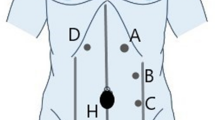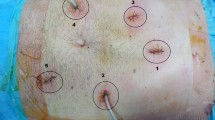Abstract
Background
Laparoscopy for ventral hernia repair is now an established technique with its proven benefits of less pain, early recovery, low-recurrence rate as compared to open repair. Several techniques have been described such as IPOM, MILOS, TES, EMILOS, SCOLA, e-TEP. e-TEP was originally conceptualized as an alternative approach to inguinal hernia in difficult cases (obese, previous scars) and for training surgery residents. Application of this approach for ventral hernia repair has recently been reported by few surgeons. We present our experience of e-TEP approach for ventral hernia from a tertiary care center in South India over one year duration.
Materials and methods
Electronically maintained data of patients who underwent e-TEP for ventral hernia during a period of November 2017 to November 2018 was reviewed retrospectively. Their demographic data, intraoperative details, postoperative complications and follow up data for a period of 6 months was noted.
Results
171 patients underwent e-TEP approach ventral hernia repair. Mean age was 49.34 ± 10.75 years with hypertension being most common comorbidity. Mean BMI was 29.2 ± 4.1 kg/m2. Mean defect area was 51.35 ± 45.09 cm2 and mean mesh size used was 397.56 ± 208.83 cm2. Fifty patients required TAR. Mean duration of surgery was 176.75 ± 62.42 min and blood loss was 78.7 ± 24.4 ml. Mean length of stay was 2.18 ± 1.27 days. Seven cases had paralytic ileus, 5 cases had surgical site infection, and 3 cases had recurrence at 6 months follow up.
Conclusion
e-TEP is a minimally invasive approach which is safe, feasible and also avoids placement of mesh in peritoneal cavity. Since it is a relatively new approach it requires further studies for standardization of techniques, criteria for patient selection and to study long-term outcomes.











Similar content being viewed by others
References
LeBlanc KA, Booth WV (1993) Laparoscopic repair of incisional abdominal hernias using expanded polytetrafluoroethylene: preliminary findings. Surg Laparosc Endosc 3(1):39–41
Muysoms FE, Bontinck J, Pletinckx P (2011) Complications of mesh devices for intraperitoneal umbilical hernia repair: a word of caution. Hernia 15(4):463–468
Ramakrishna HK, Lakshman K (2013) Intra peritoneal polypropylene mesh and newer meshes in ventral hernia repair: what ebm says? Indian J Surg 75(5):346–351
Bittner R, Bain K, Bansal VK, Berrevoet F, Bingener-Casey J, Chen D et al (2019) Update of Guidelines for laparoscopic treatment of ventral and incisional abdominal wall hernias (International Endohernia Society (IEHS)): Part B. Surg Endosc 33(11):3511–3549
Claus CMP, Malcher F, Cavazzola LT, Furtado M, Morrell A, Azevedo M et al (2018) SUBCUTANEOUS ONLAY LAPAROSCOPIC APPROACH (SCOLA) FOR VENTRAL HERNIA AND RECTUS ABDOMINIS DIASTASIS REPAIR: TECHNICAL DESCRIPTION AND INITIAL RESULTS. Arq Bras Cir Dig 31(4):e1399
Chowbey PK, Sharma A, Khullar R, Soni V, Baijal M (2003) Laparoscopic ventral hernia repair with extraperitoneal mesh: surgical technique and early results. Surg Laparosc Endosc Percutan Tech 13(2):101–105
Reinpold W, Schröder M, Berger C, Nehls J, Schröder A, Hukauf M et al (2019) Mini- or Less-open Sublay Operation (MILOS). Ann Surg 269(4):748–755
Jani K, Contractor S (2019) Retrorectus sublay mesh repair using polypropylene mesh: Cost-effective approach for laparoscopic treatment of ventral abdominal wall hernias. J Minim Access Surg 15(4):287
Li B, Gong D, Miao J, Nie X, Qin C (2018) Totally endoscopic sublay repair (TES)—a novel approach to repair midline ventral hernia. Natl Med J China 98(36):2933–2936
Daes J (2012) The enhanced view—totally extraperitoneal technique for repair of inguinal hernia. Surg Endosc 26(4):1187–1189
Muysoms FE, Miserez M, Berrevoet F, Campanelli G, Champault GG, Chelala E et al (2009) Classification of primary and incisional abdominal wall hernias. Hernia 13(4):407–414
Köckerling F, Stechemesser B, Hukauf M, Kuthe A, Schug-Pass C (2016) TEP versus Lichtenstein: Which technique is better for the repair of primary unilateral inguinal hernias in men? Surg Endosc 30(8):3304–3313. https://doi.org/10.1007/s00464-015-4603-1
Feliu X, Clavería R, Besora P, Camps J, Fernández-Sallent E, Viñas X et al (2011) Bilateral inguinal hernia repair: laparoscopic or open approach? Hernia 15(1):15–18
Belyansky I, Daes J, Radu VG, Balasubramanian R, Reza Zahiri H, Weltz AS et al (2018) A novel approach using the enhanced-view totally extraperitoneal (eTEP) technique for laparoscopic retromuscular hernia repair. Surg Endosc 32(3):1525–1532
Baig S, Priya P (2019) Extended totally extraperitoneal repair (eTEP) for ventral hernias: Short-term results from a single centre. J Minim Access Surg 15(3):198
Novitsky YW, Elliott HL, Orenstein SB, Rosen MJ (2012) Transversus abdominis muscle release: a novel approach to posterior component separation during complex abdominal wall reconstruction. Am J Surg 204(5):709–716
Ott V, Groebli Y, Schneider R (2005) Late intestinal fistula formation after incisional hernia using intraperitoneal mesh. Hernia 9(1):103–104
Bittner R, Bingener-Casey J, Dietz U, Fabian M, Ferzli GS, Fortelny RH et al (2014) Guidelines for laparoscopic treatment of ventral and incisional abdominal wall hernias (International Endohernia Society [IEHS])—Part 2. Surg Endosc 28(2):353–379
Penchev D, Kotashev G, Mutafchiyski V (2019) Endoscopic enhanced-view totally extraperitoneal retromuscular approach for ventral hernia repair. Surg Endosc 33(11):3749–3756. https://doi.org/10.1007/s00464-019-06669-2
Schreinemacher MHF, van Barneveld KWY, Dikmans REG, Gijbels MJJ, Greve JW, Bouvy ND (2013) Coated meshes for hernia repair provide comparable intraperitoneal adhesion prevention. Surg Endosc 27(11):4202–4209
Bittner R, Bingener-Casey J, Dietz U, Fabian M, Ferzli G, Fortelny R et al (2014) Guidelines for laparoscopic treatment of ventral and incisional abdominal wall hernias (International Endohernia Society [IEHS])—part III. Surg Endosc 28(2):380–404. https://doi.org/10.1007/s00464-013-3172-4
Srivastava A, Sood A, Joy PS, Mandal S, Panwar R, Ravichandran S et al (2010) Principles of physics in surgery: the laws of mechanics and vectors physics for surgeons—part 2. Indian J Surg 72(5):355–361
Li B, Qin C, Bittner R (2018) Totally endoscopic sublay (TES) repair for midline ventral hernia: surgical technique and preliminary results. Surg Endosc 34(4):1543–1550
Schwarz J, Reinpold W, Bittner R (2017) Endoscopic mini/less open sublay technique (EMILOS)—a new technique for ventral hernia repair. Langenbeck’s Arch Surg 402(1):173–180
Funding
No financial support was required for this study.
Author information
Authors and Affiliations
Corresponding author
Ethics declarations
Disclosures
Dr. Gupta Prakhar, Dr. Ramakrishnan Parthasarathi, Dr. Bharath Cumar, Dr. Rajapandian Subbaiah, Dr. V.P Nalankilli, Dr. P Praveen Raj and Dr. Chinnusamy Palanivelu have no conflicts of interest or no financial ties to disclose.
Additional information
Publisher's Note
Springer Nature remains neutral with regard to jurisdictional claims in published maps and institutional affiliations.
Rights and permissions
About this article
Cite this article
Prakhar, G., Parthasarathi, R., Cumar, B. et al. Extended View: Totally Extra Peritoneal (e-TEP) Approach for Ventral and Incisional Hernia—Early results from a single center. Surg Endosc 35, 2005–2013 (2021). https://doi.org/10.1007/s00464-020-07595-4
Received:
Accepted:
Published:
Issue Date:
DOI: https://doi.org/10.1007/s00464-020-07595-4




